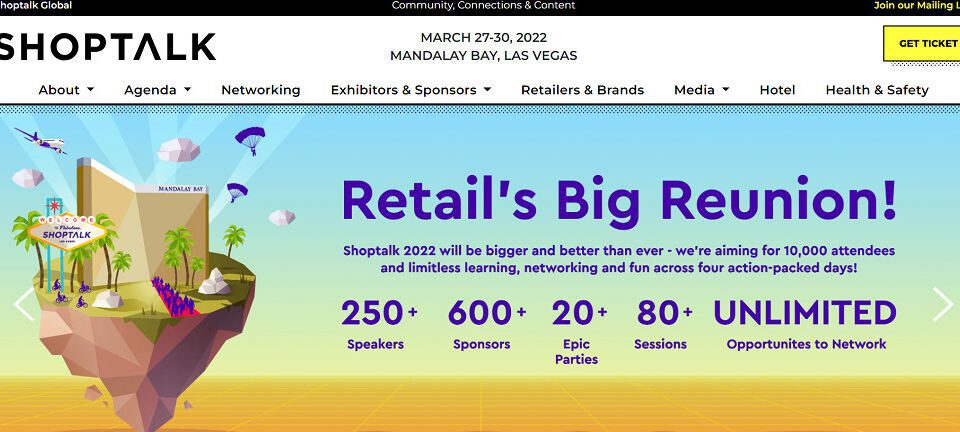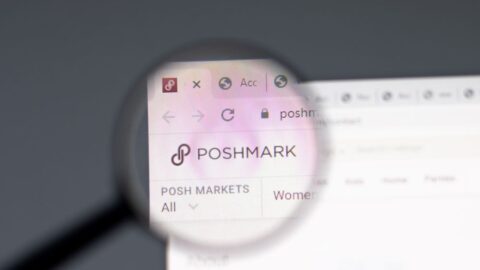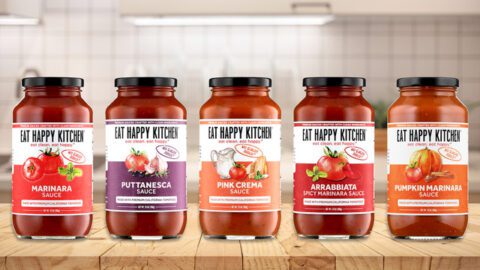Nearly 10,000 attendees crowded into the Mandalay Bay Hotel in Las Vegas for Shoptalk 2022, held March 27-30, to walk the exhibit hall floor and hear from more than 280 speakers. Three up-to-the-minute themes emerged from a wide range of sessions on both the event’s mainstage and in breakout sessions:
- The accelerating importance of social commerce and community-building for brands and retailers;
- Practical personalization strategies for the cookie-free future; and
- Maximizing sustainability with innovations in product packaging.
The Art of Listening
“With most brands the product comes first, but we started with the community first,” said actress Brooke Shields, Founder and CEO of the digital wellness platform Beginning is Now, which is aimed at women over 40. “As an actress you’re expected to be in your 20s forever, but [women in general] are not marketed to after 40,” Shields added. “There’s marketing to people in their 20s and then [it skips to] Depends, but there’s a whole section in-between. Women control most of the spending in our households, and as a woman we have so much more to give.”
Shields has put a premium on listening to this community as an integral part of developing products and services that Beginning is Now might sell. “We didn’t want to start with things to buy; we wanted the investment to be emotional first,” she noted.
She knows what it’s like to not be listened to: “Today, they want models to have opinions. When I was coming up that was the last thing they wanted from models.” Shields credited the power of social media in helping fuel trends such as body positivity and inclusivity, and said that “accessibility to that information is empowering in and of itself. Our goal is to empower women to not be afraid to take on new chapters in their life.”
Natalie Mackey, Co-founder and CEO of makeup and skincare brand Winky Lux, also believes in the power of community to shape the company’s path: “We’re not an influencer brand,” she noted. “I’m not a makeup artist or a dermatologist; it’s the customers who are evangelizing the brand. We have a commitment to taking more of their feedback and using it to make us grow.”
Having a solid retail platform also helps with growth, she added, commenting on the brand’s 2020 chainwide launch in Target stores. “The things we wanted to do [within Target] would have been completely disruptive in other retail stores,” said Mackey. “They let us put neon signs in as well as a 3D lenticular image where you see Marisa, a face of the brand, putting on and taking off lipstick. That’s created a lot of social media impressions, and we won Target’s Vendor of the Year award last year. Having a retail partner that’s ready to ‘hold hands’ is important, and they also come to us for innovation because we can make stuff faster than our competitors.”
Finding Personalization’s Sweet Spots
The approaching sunset of cookies and increased consumer concerns about privacy are pushing retailers to find new ways to personalize everything from product recommendations to communications preferences. Several speakers noted that many customers are willing to share valuable information and even respond to specific questions, but that these queries need to be used and executed strategically.
“We’re going all in on explicitly asking questions of customers as an educational piece that we’re unlocking at eBay,” said Bradford Shellhammer, VP of Buyer Experience at eBay. “However, you need to do this contextually, and not overwhelm someone with a test or too much to do. You do it in bits and pieces when it’s the right thing to do and the right time. For example, it could be ‘You’ve looked at this [item] five times, do you want to add it to your watch list and get a notification when the price goes down?’”
Julie Bornstein, Co-Founder and CEO of THE YES, drew a distinction between implicit and explicit data. When she worked at Stitch Fix, “it’s all explicit; [customer interactions] start with a 40-question quiz, supplemented with a little bit of feedback over the year, for example if someone rated a product. But there are also ways to layer in implicit signals that are more meaningful than others, such as the taxonomy and attributes of a product.
“We’re customers [ourselves], so we understand when recommendations are random and have nothing to do with us,” Bornstein added. “However, if you know the category, the consumer and what matters, you can build a whole system that’s intelligent. Media businesses have figured this out, but commerce is lagging. It’s the next wave.”
User-generated content can be a powerful personalization tool when a retailer has built a strong community, as Sephora has done. “Imagine browsing a product page shopping for shampoo and the product reviews are from clients that share your hair type,” said Nadine Graham, VP of Digital Client Experience at the retailer. “That’s instantly relatable. Or if you saw the shade of lipstick that you’ve been coveting and the [content shown] is from clients with the same skin, hair and eye tones. That shows the multiple dimensions of UGC.”
Relevant product recommendations are such a hot commodity that one retailer is looking to sell its technology to other retailers. “It took us 2.5 years to shape our recommendations engine, and we scaled it to all seven of our brands in 2021, where it’s driven $100 million in incremental revenue,” said Yasir Anwar, CTO and Digital Officer at Williams-Sonoma. Another technology the retailer is making available is its Outward Room Planner: “We acquired a computer vision company and have converted all the SKUs on our websites into 3D assets,” said Anwar. “That’s very important capital for building rich, immersive experiences.”
True Sustainability Will Require Packaging Changes
Decisions brands make about how (and with what) their products are packaged can have a profound impact on sustainability efforts. “Some beauty categories are very focused on their packaging; they want an outer box to market their product,” noted Jue Wong, CEO of haircare brand Olaplex. “We don’t use a secondary box, and we can document the [impact on] sustainability. Prevention is better than a cure. If every brand could choose one product and eliminate the secondary packaging, the impact can be tremendous.”
Grove Collaborative Co-founder and CEO Stu Landesberg is sounding the alarm about packaging, specifically plastics: “Plastic packaging represents nearly half of all plastic waste, and the consumer goods industry is a major contributor,” he said. His focus on plastic is deliberate; he sees it as a way to cut through any remaining controversies about humans’ impact on the earth’s ecology.
“Very few people dispute the existence of a plastic water bottle,” he noted, revealing that the company already has saved nearly 10 million pounds of plastic and that by 2025 all the products Grove sells will be totally plastic-free.
The retailer’s offerings include small bottles of concentrated household and cleaning products that consumers mix with water, but Landesberg acknowledged that weaning consumers away from big plastic bottles of laundry detergent, for example, isn’t an easy task. “The brands in our homes are part of your identity, and they are some of the strongest brands in the world,” said Landesberg. “But people want to try [more sustainable alternatives.] Ultimately, consumers don’t want big heavy plastic bottles; they want their laundry to get clean.
“If you overdeliver during the trial period, not just from the standpoint of sustainability but in terms of efficacy and value, that can affect the way we think about any cost-sustainability tradeoffs,” Landesberg added. “And the bottom line is that if we don’t solve these problems, we’re all screwed.”













